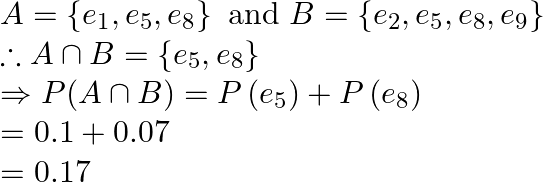Solution:
It is given that

(a) We need to find ![]() and
and ![]()
![]()
![]()
Substitute the values, now
![]()
![]()
![]()

Substituting the values,
![Rendered by QuickLaTeX.com \begin{array}{l} \Rightarrow P(B)=0.08+0.1+0.07+0.07 \text { [given }] \\ \Rightarrow P(B)=0.32 \end{array}](https://www.learnatnoon.com/s/wp-content/ql-cache/quicklatex.com-b8443b1612e7f800574e39a611fb485e_l3.png)
We now need to find ![]()

(b) We need to find ![]()
Using the General Addition Rule:
![]()
From the part (a), we have
![]()
Putting the values,

